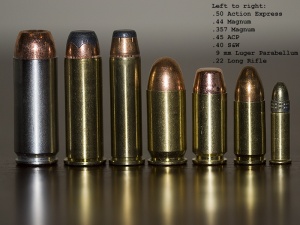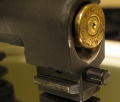.40 Smith & Wesson
| .40 S&W | ||||||||||||||||||||||
|---|---|---|---|---|---|---|---|---|---|---|---|---|---|---|---|---|---|---|---|---|---|---|

| ||||||||||||||||||||||
| .40 S&W compared to other cartridges (third from right). | ||||||||||||||||||||||
| Type | pistol | |||||||||||||||||||||
| Country of Origin | USA | |||||||||||||||||||||
| Specifications | ||||||||||||||||||||||
| Parent Case | 10mm Auto | |||||||||||||||||||||
| Case Type | Rimless, straight | |||||||||||||||||||||
| Bullet Ø | .40 in (10 mm) | |||||||||||||||||||||
| Neck Ø | .423 in (10.7 mm) | |||||||||||||||||||||
| Base Ø | .424 in (10.8 mm) | |||||||||||||||||||||
| Rim Ø | .424 in (10.8 mm) | |||||||||||||||||||||
| Rim Thickness | .055 in (1.4 mm) | |||||||||||||||||||||
| Case Length | .850 in (21.6 mm) | |||||||||||||||||||||
| Full Length | 1.135 in (28.8 mm) | |||||||||||||||||||||
| Primer | Small pistol | |||||||||||||||||||||
| Production & Service | ||||||||||||||||||||||
| Designer | Smith & Wesson | |||||||||||||||||||||
| Design Date | 1989 (debut January 17, 1990) | |||||||||||||||||||||
| Manufacturer | everybody | |||||||||||||||||||||
| Production Dates | 1990-present | |||||||||||||||||||||
| Ballistic Performance Sampling | ||||||||||||||||||||||
| ||||||||||||||||||||||
The .40 S&W (10x22mm Smith & Wesson) is a rimless pistol cartridge developed jointly by Winchester and Smith & Wesson, two famous American firearms manufacturers. [1] It uses .400-inch (10.16 mm) diameter bullets ranging in weight from 135 to 200 grains (9 g to 13 g) and operates at about 33,000 psi (230 MPa) pressure.
Contents |
[edit] History
In the aftermath of the 1986 FBI Miami shootout the FBI started the process of upgrading their service arms to a weapon of much greater power than their collection of 9x19mm Parabellum automatics and .38 Special revolvers. This search led them to the 10 mm Auto that had been developed in the early 1980s for the famed Bren Ten, but by this point in time the company had already gone out of business. The FBI then contracted Smith & Wesson to develop a new automatic for the 10 mm Auto, creating the Smith & Wesson 1076.
In service, the 1076 proved to be an unwieldily weapon, the recoil and muzzle blast, especially from a short barrel, were found to be too much for many shooters. The FBI asked for several changes to the 10 mm Auto, using a reduced-charge version often referred to as the "FBI load" or "10mm lite." Smith & Wesson then redesigned the cartridge to make it shorter while maintaining the performance of the FBI loading. They also decided to use a small pistol primer, rather than the large primer used for the 10 mm Auto. With the .40 S&W being shorter than the 10 mm Auto and approximately the same overall length as the 9x19mm Parabellum cartridge, many existing 9 mm pistols could be easily adapted by their respective manufacturers to fire the new cartridge.
The .40 S&W cartridge debuted January 17, 1990 along with the new Smith & Wesson Model 4006 pistol, although it was several months before the pistols were available for purchase. Austrian manufacturer Glock beat Smith & Wesson to the dealer shelves in 1990, with pistols chambered in .40 S&W (the Glock 22 and 23) which were announced a week after the 4006.[2] Glock's rapid introduction was aided by its engineering of a pistol chambered in 10 mm Auto, the Glock 20, only a short time earlier. Since the .40 S&W uses the same bore diameter and case head as the 10 mm Auto, it was merely a matter of adapting the 10 mm design to the shorter 9x19mm frames.
Initial acceptance of the .40 S&W was slow, since the round was considerably less powerful than the 10 mm Auto it was based on. This led to derogatory names such as ".40 Short and Wimpy" or ".40 Short and Weak."[3][4]
The 40 S & W is dimensionally identical to the 10 mm Auto except for length. Both cartridges headspace on the mouth of the case. Thus in a semi-auto they are not interchangeable. Smith and Wesson does make a double action revolver that can fire either at will using moon clips. A single-action revolver in the 38-40 chambering can also be modified to fire the .40 or the 10 mm if it has an extra cylinder. The .40 will at short range take deer with loads that come close enough to the combination of .40 caliber or better, 200 grains (13 g) bullet or better, and 1,000 feet per second (300 m/s) or better. It is also suitable for small and medium game.
IMI attempted a similar cartridge in the 1980s, called the .41 Action Express (or .41 AE) for the Jericho 941 pistol. This cartridge was based on the .41 Magnum case, cut down to fit in a 9 mm frame, and using a rebated rim the same diameter as the 9 mm Luger. The .41 AE is ballistically similar to the .40 S&W, to the point that many reloading manuals suggest using .40 S&W load data in the .41 AE. The .41 AE is a more attractive cartridge in many ways, as the rebated rim allows a simple barrel and magazine change to allow most 9 mm guns to be converted to .41 AE. The .41 AE uses .410 inch bullets, whereas the .40 S&W uses .400 inch bullets. However, as it lacks the backing of ammunition manufacturers in making .410 caliber bullets suited to semiautomatic pistols, the .41 AE has not achieved widespread popularity.[5][6]
[edit] Performance

The energy of the .40 S&W exceeds all standard-pressure and +P 9x19mm Parabellum loadings and many standard-pressure .45 ACP rounds, generating between 450 and 600 foot-pounds (550 J and 800 J) of energy, depending on bullet weight, with mid to high 500 foot-pounds typical. Both the .40 S&W and the 9 mm Parabellum operate at a 35,000 psi (240 MPa) SAAMI maximum, compared to a 21,000 psi (150 MPa) maximum for .45 ACP[9]. Some small ammunition manufacturers offer .40 S&W ammunition consistently developing energy well above 500 ft·lbf (700 J) in all their .40 S&W ammo as off-the-shelf items.[10]. While SAAMI has not established a +P standard for the .40 S&W, there are companies marketing ammunition claimed to be +P, but they do not provide pressure data to support +P labeling.
The .40 S&W is considered by some the best cartridge for law enforcement use available today, combining superior stopping power when using expanding ammunition and manageable recoil in a package that remains compact, even when using a double-stack magazine. The .40 S&W has an overwhelming share of the U.S. law enforcement market as a result.
Despite the .40 S&W's great popularity amongst American law enforcement and the private sector, it has yet to be adopted by a significant number of military forces worldwide. The mainstay for military use in the western world largely remains the preserve of the 9 mm Parabellum, or for a few special forces, .45 ACP in their respective adopted handguns. The United States Coast Guard, however, has adopted the Sig Sauer P229R DAK in .40 S&W as their standard sidearm.
There are two major reasons for western militaries' choice of ammunition. The first reason is quite simply that the .40 S&W is not a NATO cartridge, and standardization is very important for logistical purposes.
The second major reason for .40 S&W not being chosen by military forces is the expense of procurement, purchasing and stocking spare parts, training of weapons techs to service and repair firearms, etc. The handgun is primarily a secondary firearm in the military forces of any country, and the expense can not be justified by whatever improvement is available over 9 mm equipment currently in stock for a secondary firearm. Special units, of course, are often free to use whatever they feel best suits their purposes and have designated funding to deal with that.
Since American law enforcement agencies are not bound by these constraints, most have chosen the .40 S&W round for its excellent ammunition capacities, accuracy, and superior ballistic performance.
[edit] Case failure reports
The .40 S&W has been noted in a number of cartridge case failures, particularly in Glock pistols due to the relatively large area of unsupported case head in those barrels, given its high working pressure[11]. The feed ramp on the Glock .40 S&W pistols are larger than normal, which leaves the rear bottom of the case unsupported, and it is in this unsupported area that the cases fail. Most, but not all, of the failures have occurred with reloaded or remanufactured ammunition. Cartridges loaded at or above the SAAMI pressure, or slightly oversized cases which fire slightly out of battery are often considered to be the cause of these failures. These failures are referred to by many as "kaBooms" or "kB!" for short. While these case failures do not often injure the person holding the pistol, the venting of high pressure gas tends to eject the magazine out of the magazine well in a spectacular fashion, and usually destroys the pistol. In some cases, the barrel will also fail, blowing the top of the chamber off.
While the .40 S&W is far from the only cartridge to suffer from case failures, it is more susceptible for a number of reasons. The .40 S&W works at fairly high pressures (33,000 psi/230 MPa typical, but 35,000 psi/240 MPa SAAMI max) for a large caliber handgun cartridge, significantly more than, say, the .45 ACP.[12] Since the .40 S&W is a wide cartridge for its length, and is often adapted to frames designed for the equally long but narrower 9x19mm cartridge, the length of the feed ramp must be longer to provide the same angle, which causes the feed ramp to extend into the chamber. This in turn leaves more of the case head unsupported. While this is not necessarily unsafe, it does reduce the margin of safety; when exacerbated by out of battery firing (leaving even more case head exposed) and potentially weakened brass (due to reloading) these factors appear to lead to the higher incidents of chamber failure. The number of case failures in the .40 S&W is serious enough that Accurate Arms no longer recommends reloading of .40 S&W cartridges for firearms without complete case head support.[13]
[edit] Synonyms
- .40
- .40 S&W
- .40 Liberty (promoted by L. Neil Smith as part of a boycott of Smith and Wesson for making an agreement with the U.S. government under President Bill Clinton.[14][15][16]
- .40 Short & Weak (a derogatory comparison to the parent 10 mm Auto cartridge)
[edit] See also
[edit] References
- ↑ Taffin Tests: The .40 S&W
- ↑ The .40 Smith & Wesson: this round came along at the right time in the right place
- ↑ Smith & wesson model compact: Good looking and great shooting, petty finds that there is a lot to like about this new offering from the S&W performance center
- ↑ Gossip, finger-pointing and whispers
- ↑ SAAMI Pressures
- ↑ .40 Smith & Wesson/.41 AE
- ↑ New Life For An Old Cat (Stoeger Model 8000 Cougar)
- ↑ [Scientific Evidence for Hydrostatic Shock
- ↑ http://www.handloads.com/misc/saami.htm SAAMI Pressure specifications]
- ↑ .40 S&W 135gr Nosler JHP 50rds.
- ↑ .40 S&W Case Failures in Glocks
- ↑ SAAMI Pressures
- ↑ Safety Accurate Arms
- ↑ 40S&W Name Change 40 Liberty+++ [Archive] - TheFiringLine Forums
- ↑ Smith & Wesson Must Die, by L. Neil Smith
- ↑ Smith & Wesson Must Die
[edit] External links
- Ballistics concerning .40 S&W from Hodgdon Powder Co.
- Hodgdon/IMR/Winchester's Online Reloading Center
- Reloading Tables with MV, ME & Group Sizes (no pressures)
- IPSC Competition Reloading Guide
- Reloading Data from HandLoads Website
- Firearms Tactical Institute Ammunition Performance Data
- Ballistic Gel Testing Results
- FBI: Handgun Wounding Factors & Effectiveness
- .40 S&W Shooting Videos


